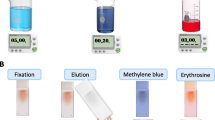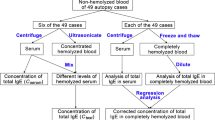Summary
Glycolipids extracted from groups A, B, and 0 erythrocytes were developed on thin-layer plates; their AB0 blood group antigenicities were detected by immunostaining method using avidin-biotin-complex (ABC). Among series of glycolipids of different flow rates, antigen-specific staining was observed in five bands from group A1 erythrocytes, four bands from group B, and two bands from group O. Monoclonal anti-A, -B, and -H antibodies specifically stained glycolipids from A1, B, and 0 erythrocytes, respectively.
AB0 blood grouping was possible from 5 g of epidural heat hematoma of a charred body by this method. ABC immunostaining on thin-layer chromatography is a useful and reliable method for AB0 blood grouping in forensic practice.
Zusammenfassung
Glycolipide, welche von Erythrozyten der Blutgruppen A, B und 0 extrahiert wurden, wurden mittels der Dünnschichtchromatographie nachgewiesen; ihre AB0-Blutgruppenprägung wurde mit Hilfe der Immunfärbungsmethode unter Verwendung von Avidin-Biotin-Complexen nachgewiesen. Unter den Serien von Glycolipiden mit verschiedenen Fließgeschwindigkeiten wurden antigenspezifische Färbungen in fünf Banden von Erythrozyten der Blutgruppe A festgestellt, in vier Banden von Erythrozyten der Blutgruppe B und in 2 der Blutgruppe 0. Monoklonale Anti-A, B- und H-Antikörper färbten spezifisch Glycolipide der jeweiligen Erythrozyten.
Im Falle einer verkohlten Leiche war die AB0-Blutgruppenbestimmung aus 5 g eines epiduraden Hitze-Hämatoms möglich. Die Immunfärbung mit Hilfe des Avidin-Biotin-Complexes auf Dünnschichtchromatographie-Platten ist eine nützliche und zuverlässige Methode für die AB0-Blutgruppenbestimmung in der forensischen Praxis.
Similar content being viewed by others
References
Magnani JL, Brockhaus M, Smith DF, Ginsburg V (1981) Monosialoganglioside is a monoclonal antibody-defined antigen of colon carcinoma. Science 212:55–56
Magnani JL, Brockhaus M, Smith DF, Ginsburg V (1982) Detection of glycolipid ligands by direct binding of carbohydrate-binding proteins to thin-layer chromatograms. Methods Enzymol 83:235–241
Hansson GC, Karlsson K-A, Larson G, Samuelsson BE, Thurin J, Bjursten LM (1985) Detection of blood group type glycosphingolipid antigens on thin-layer plates using polyclonal antisera. J Immunol Methods 83:37–42
Folch J, Lees M, Sloane-Stanley GH (1957) A simple method for isolation and purification of total lipids from animal tissues. J Biol Chem 226:497–509
Guesdon J-L, Ternynck T, Avrameas S (1979) The use of avidin-biotin interaction in immunoenzymatic techniques. J Histochem Cytochem 27:1131–1139
Sternberger LA, Hardy PH, Cuculis JJ, Meyer HG (1970) The unlabelled antibody enzyme method of immunohistochemistry: Preparation and properties of soluble antigen-antibody complex (horseradish peroxidase-antiperoxidase) and its use in identification of spirochaetes. J Histochem Cytochem 18:315–333
Clausen H, Watanabe K, Kannagi R, Levery SB, Nudelman E, Arano-Tomono Y, Halomori S (1984) Blood group A glycolipid (Ax) with globo-series structures which is specific for blood group A1 erythrocytes: One of the chemical bases for A1 and A2 distinction. Biochem Biophys Res Commun 124:523–529
Clausen H, Levery SB, Nudelman E, Tsuchiya S, Hakomori S (1985) Repetitive A epitope (type 2 chain A) defined by blood group A1-specific monoclonal antibody TH-1: chemical basis of qualitative A1 and A2 distinction. Proc Natl Acad Sci USA 82:1199–1203
Breimer M, Samuelsson BE (1986) The specific distribution of glycolipid-based blood group A antigen in human kidney related to A1/A2, Lewis, and secretor status of single individuals. Transplantation 42:88–91
Hakomori S (1986) Chemistry of blood groups: Structural polymorphism and on-codevelopmental changes. JJSBT 32:544–556
Hakomori S (1981) Blood group ABH and Ii antigens of human erythrocytes. Semin Hematol 18:39–62
Hakomori S, Stellner K, Watanabe K (1972) Four antigenic variants of blood group A glycolipid: Examples of highly complex, branched chain glycolipid of animal cell membrane. Biochem Biophys Res Commun 49:1061–1068
Watanabe K, Laine RA, Hakomori S (1975) On neutral fucoglycolipids having long branch carbohydrate chains: H-active glycosphingolipids in human erythrocyte membranes. Biochemistry 14:2725–2733
Fukuda MN, Hakomori S (1982) Structure of branched blood group A-active glycosphingolipids in human erythrocytes and polymorphism of A- and H-glycolipids in A1 and A2 subgroups. J Biol Chem 257:446–455
Hanfland P (1975) Characterization of B and H blood group active glycosphingolipids from human B erythrocyte membranes. Chem Phys Lipids 15:105–124
Hanfland P, Kordowicz M, Niermann H, Egge H, Dabrowski U, Peter-Katalinic J, Dabrowski J (1984) Purification and structures of branched and blood-group-B-active glycosphingolipids from human erythrocyte membranes. Eur J Biochem 145:531–542
Nagano T, Tsuji K, Ieda K (1976) Blood group determination of severely charred bodies — The effects of heating on the blood group activity of A, B, AB and 0(H) active glycolipids and A and B active glycoproteins. J Forens Sci Soc 16:163–168
Author information
Authors and Affiliations
Additional information
Supported in part by a scientific grant from the Ministry of Education, Science, and Culture, Japan
Rights and permissions
About this article
Cite this article
Ota, M., Fukushima, H., Yonemura, I. et al. Detection of AB0 blood group-active glycolipids extracted from red cell membrane and heat hematoma using TLC-immunostaining. Z Rechtsmed 100, 215–221 (1988). https://doi.org/10.1007/BF00200762
Received:
Issue Date:
DOI: https://doi.org/10.1007/BF00200762




